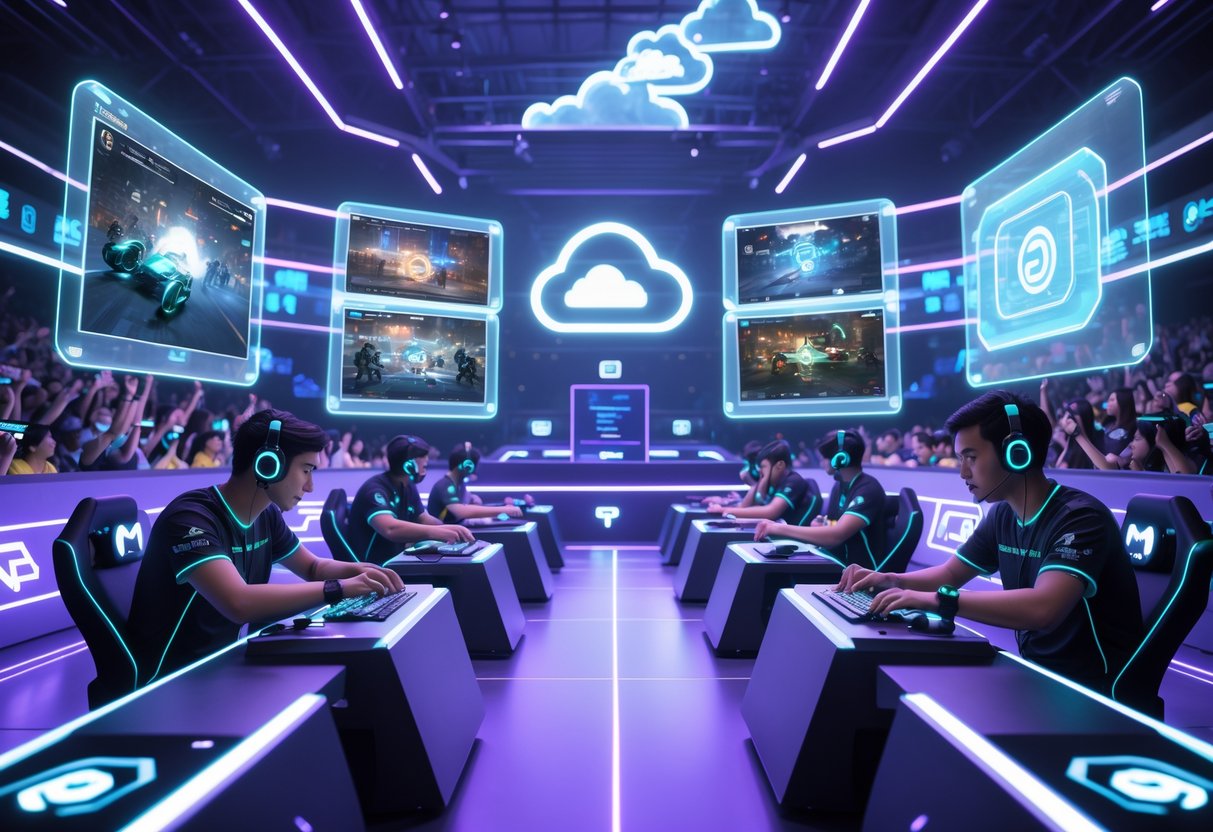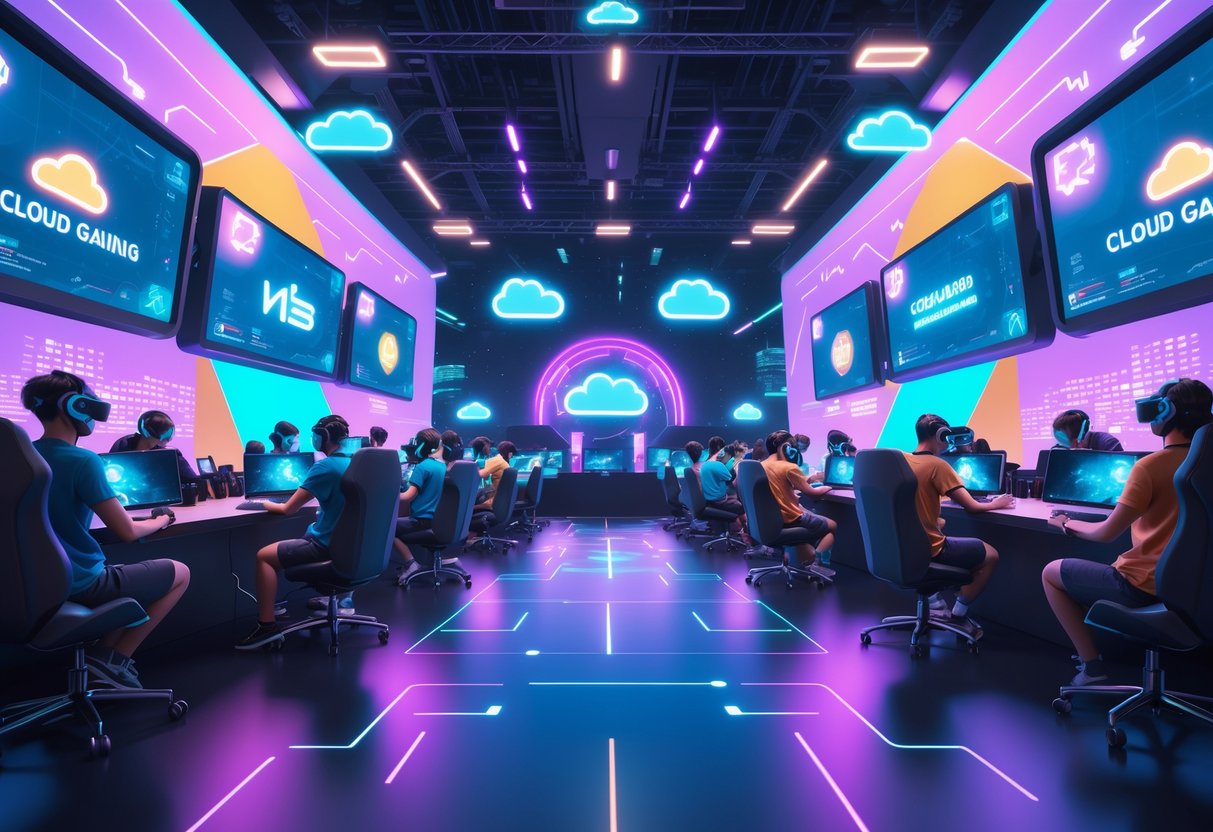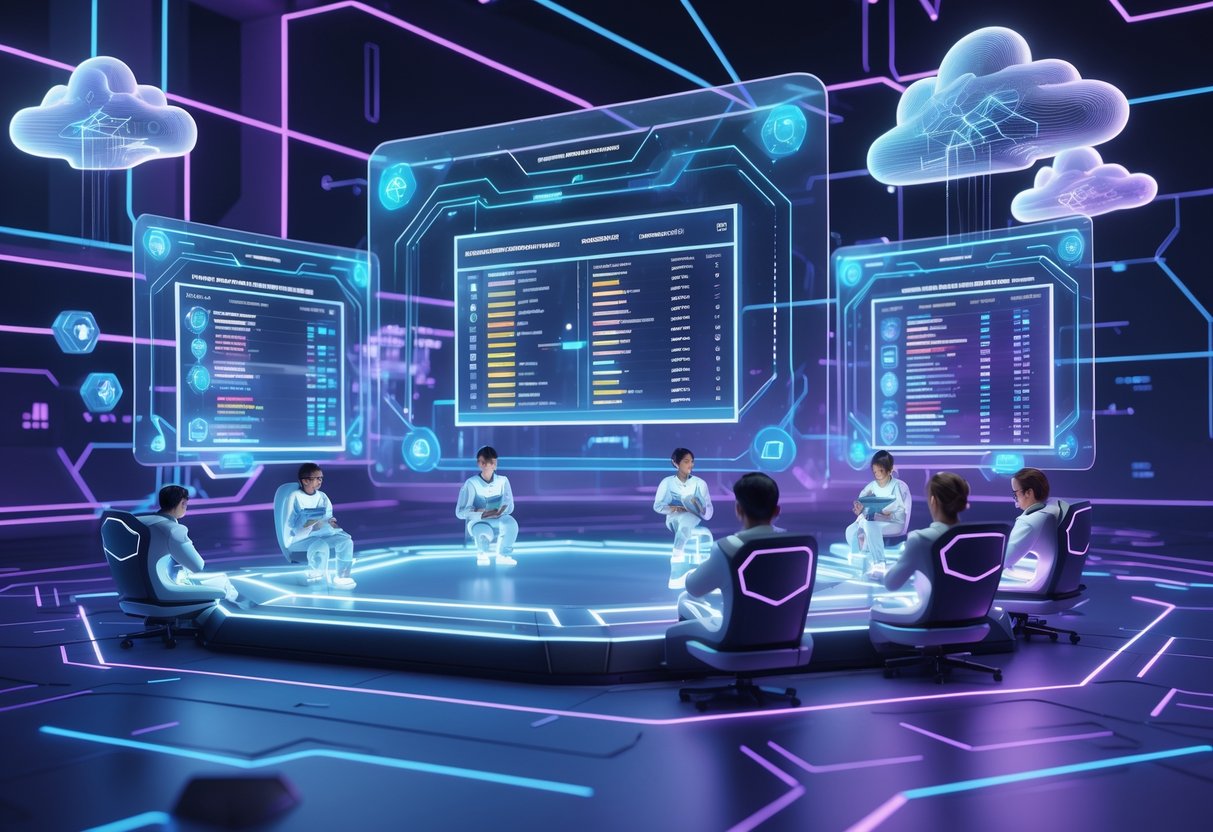Cloud Gaming Competitions: Everything Players Need to Know
Updated On: November 13, 2025 by Aaron Connolly
What are Cloud Gaming Competitions?

Cloud gaming competitions bring players together in esports tournaments where everyone plays games streamed from remote servers, not their own machines. You don’t need a fancy gaming PC or console; advanced streaming tech keeps things fair and competitive.
Key Features of Cloud-Based Competitive Play
Universal Hardware Access really sets cloud gaming competitions apart. Anyone can jump in using just a smartphone, tablet, or an old laptop. All the heavy lifting happens in the cloud, so your device just needs to connect.
Most events only ask for a stable internet connection—somewhere between 15 and 25 Mbps. Suddenly, gamers who never had a shot because of pricey hardware can join the fray.
Cross-Platform Competition gets a lot easier with cloud tech. Players on different devices face off in the same match. It’s wild to see someone on a mobile phone take on a laptop player, and neither side gets a technical edge.
Real-time leaderboards and built-in streaming make spectating a lot more interesting. Fans can watch live matches and check stats or brackets at the same time.
Prize pools swing from £500 up to over £100,000 for the big events. NVIDIA GeForce Now and Xbox Cloud Gaming run regular tournaments in all sorts of genres.
Geographic Flexibility means just about anyone with decent internet can join, even if they live far from any major city. No need to travel—players from rural areas go head-to-head with city gamers on equal terms.
How Cloud Gaming Differs From Traditional Esports
Hardware Requirements really set cloud gaming apart from traditional esports. Old-school tournaments demand expensive PCs or consoles—sometimes £1,500 or more.
Cloud competitions toss out those barriers. Suddenly, your skill matters more than the gear you own.
Latency Considerations add a new wrinkle. Local esports setups have super low input delays—like 1-5ms. Cloud gaming bumps that up to 20-50ms, depending on how far you are from the server and your internet speed.
But edge servers and 5G are closing the gap. Lots of cloud competitors say they hardly notice any extra delay during matches.
Tournament Organisation gets a lot simpler on cloud platforms. Traditional tournaments need venues, hardware, and tech teams. Cloud events run online, with automated systems taking care of most of the logistics.
Accessibility and Inclusion shoot way up. Old-school esports favor regions with strong gaming infrastructure, but cloud competitions let folks from all over the world jump in—even if they couldn’t afford the gear before.
Organisers keep things fair with anti-cheat systems and standardised servers for everyone.
Popular Cloud Gaming Tournaments

Cloud gaming tournaments now offer pro-level prize pools over £75,000 and draw players from more than 50 countries. Events range from quick, single-day showdowns to epic, multi-week championships.
Major Cloud Gaming Events
NVIDIA GeForce Now Championships lead the way with quarterly events across several games. Each one boasts prize pools over £100,000 and attracts both pros and up-and-comers.
The championship format usually starts with group stages and ends in knockout rounds. Players compete in games like Fortnite, Apex Legends, and Counter-Strike 2.
Xbox Cloud Gaming Invitationals pop up three times a year and focus on Xbox Game Pass titles. These events make it easy for mobile players to jump in.
Winners get 60% of the prize, runners-up get 25%, and third place takes 15%. Sponsorship deals with hardware brands add bonus rewards like gaming gear and subscriptions.
Google Stadia Pro Leagues (when Stadia was still around) showed how cloud platforms could host big, cross-device competitions. Stadia’s gone, but the idea lives on elsewhere.
Recurring Online Competitions
Monthly ladder tournaments keep things rolling on sites like GameBattles and FACEIT. Cloud integration means hardware doesn’t hold anyone back.
Entry fees range from free up to £15 per player. Bigger turnouts mean bigger prize pools—monthly events often pay out £500 to £2,000.
Weekly community battles keep things casual and fun, mostly on Discord or gaming forums. These usually last just a couple of hours, perfect for semi-pros or anyone looking for quick games.
Seasonal championships tally up points from monthly events and crown yearly champs. Consistency matters more than one lucky win.
Most of these events use Swiss-system brackets to match players with similar skill levels, no matter what device they use.
Top Games in Cloud Gaming Competitions

Cloud tournaments feature top battle royales like Call of Duty: Warzone and even sandbox games like Minecraft, plus the usual esports giants. Players get to compete at a high level without dropping a fortune on hardware.
Call of Duty: Warzone in the Cloud
Warzone has become the poster child for cloud gaming tournaments. The battle royale format just works on platforms like Xbox Cloud Gaming and GeForce Now.
Major tournaments have switched to cloud gaming to bring in more players. Suddenly, people in regions where gaming PCs cost a fortune can join the action.
Key competitive advantages:
- Everyone gets the same performance, no matter their device
- Nobody wins because of better hardware
- You can join tournaments instantly—no downloads needed
Organisers love running Warzone on the cloud. Setup times shrink from hours to just minutes, and players jump right in.
The massive 150-player matches run smoothly, even when things get chaotic in the final circles.
Heads up: Make sure your internet connection hits at least 20 Mbps. Anything less and you’ll probably struggle in fast gunfights.
Minecraft Competitive Events
Minecraft competitions have really exploded on cloud platforms. Speed building and PvP tournaments draw in thousands every month.
Popular formats:
- Build battles (30-minute creative showdowns)
- Hunger Games-style survival matches
- Redstone engineering contests
- Parkour racing events
Cloud gaming means you don’t even need to own or install Minecraft. Organisers set up pre-configured worlds, and everyone joins instantly.
The biggest plus? Standardised environments. Every player uses the same settings, mods, and world seeds.
Prize pools sometimes hit £10,000+ for major Minecraft cloud tournaments. The accessibility brings in players who might never have bought the game.
Tip: Try smaller build battles first to get a feel for the format before jumping into the big leagues.
Call of Duty Esports Integration
Traditional Call of Duty esports now use cloud gaming for qualifiers and amateur events. This opens doors for players without consoles to chase a pro career.
Major benefits:
- Less cheating thanks to cloud-controlled setups
- Level hardware playing field
- Anyone can join, no matter where they live
Semi-pro teams use cloud gaming for scrims and practice. They can play against teams worldwide, and timezone differences don’t mess with performance.
Industry data shows cloud-based Call of Duty qualifiers pull in 40% more players than old-school tournaments. Lower barriers bring in new talent.
Regional competitions now feed straight into pro leagues. Some players have landed contracts with big esports orgs after getting noticed in cloud tournaments.
Next move: Keep an eye on tournament calendars from sites like FACEIT and ESL for upcoming Call of Duty qualifiers.
Cross-Platform Competitive Gaming
Cloud gaming tears down the walls between devices, so players on console, PC, or mobile can all compete together. This creates bigger tournaments and makes competitive gaming way more accessible.
Enabling Seamless Multi-Device Play
Traditional gaming usually splits players by platform. Xbox folks play other Xbox users, and PC gamers stick to their own. Cloud gaming just ignores those old boundaries.
Since games run on remote servers, your device doesn’t matter much. A mobile player can take on someone with a high-end PC, and the server handles all the heavy lifting.
Key benefits:
- Players switch devices mid-tournament if they want
- No need to buy expensive gear
- Performance stays consistent for everyone
- More people can try competitive gaming
NVIDIA GeForce Now and Xbox Cloud Gaming already make this happen. Big esports platforms are starting to add cross-platform cloud tournaments, too.
The main hurdle is still latency. You’ll need a solid internet connection to stay competitive.
Advantages of Cross-Platform Tournaments
Cross-platform tournaments powered by cloud gaming give players and organisers a ton of new options. When hardware doesn’t matter, the player pool gets huge.
For events:
- Way more participants
- Wider range of skills and backgrounds
- Less gear needed for venues
- Global access—no need to ship consoles anywhere
Organisers can run tournaments for anyone, anywhere, on any device. This cuts costs and makes it easier for international players to join.
Players get to face a mix of opponents, not just the same local crowd. You’ll see all kinds of playstyles from different platforms.
Larger tournaments often mean bigger prize pools, since more players and sponsors get involved.
Hybrid events are possible now, too—some people show up in person, others play remotely.
How to Join a Cloud Gaming Competition

Jumping into cloud gaming tournaments is pretty simple. Find the right event, sign up, and you’re good to go—sometimes you can play within minutes.
Finding Tournaments Online
A few big platforms host regular cloud gaming events for all skill levels. Battlefy runs loads of tournaments across different games. CMG (Compete My Game) focuses on cash prize events for PlayStation, Xbox, and PC.
GameBattles has over 10 million registered players and supports cross-platform tournaments. That’s perfect for cloud gaming, since device differences don’t matter much.
If you’re just getting started, check out Konnect Gaming. They run friendly events and help new players get comfortable.
Tip: Check these sites weekly. Schedules change a lot, and you might get email alerts for new tournaments.
Registration and Entry Requirements
Most cloud gaming tournaments only need a basic account and proof of age. You’ll usually need:
- A valid email and gaming account
- Stable internet (25 Mbps is safest)
- Age verification (18+ for cash prizes; younger players might need parental consent)
- Entry fees that range from free to £20+ for top-tier events
Entry fees can be all over the place. Free events attract more casual players, while paid ones usually have tougher competition and bigger prizes. Most platforms offer both.
Heads up: Read the rules before signing up. Some events block certain regions or need specific game versions.
Registering takes about 5-10 minutes. Pick your games, set your skill level, and agree to the rules. Most sites let you back out before matches start if you change your mind.
Popular Platforms Hosting Cloud Gaming Tournaments

Several established platforms now run cloud gaming tournaments, each with their own features and focus. The key is to find one that fits your style, skill level, and favorite games.
Notable Tournament Platforms
Battlefy has really carved out a spot at the top of the cloud gaming tournament scene, especially with its roots in competitive esports. Back in 2013, it kicked things off with Starcraft 2 and League of Legends, and now you’ll find it hosting cloud gaming events for all sorts of titles.
You get handy bracket creation tools and community features. Most events stick with single-elimination or round-robin formats. Prize pools swing from about £50 for small stuff to over £5,000 for the big leagues.
NVIDIA GeForce Now Gaming Championship sits at the premium end of cloud tournaments. These events bring high-stakes action and a level of organisation that feels seriously pro. Thanks to the platform’s low latency tech, competitive play just works.
Toornament gives you another reliable choice for cloud gaming events. It handles a bunch of different games and lets you tweak tournament formats to fit your needs. Both casual gamers and semi-pros show up here.
UMG Gaming keeps things rolling with regular cloud-based tournaments and cash prizes. They lean into console-style games, which actually works out great for cloud gaming platforms. Entry fees range from free up to £20.
Choosing the Right Platform for You
Make sure your skill level fits the competition on the platform. Battlefy, for example, has beginner-friendly tournaments as well as pro ones. Skim through recent results to get a feel for the kind of players you’ll face.
Check which games each platform supports. Some focus on battle royales, others on MOBAs or something else entirely. If you have a favourite, double-check that regular tournaments are running for it.
Take a close look at prize structures and entry fees. Free tournaments are a solid way to get practice, but paid entries (£5–£50) usually mean better prizes. Set your budget before you dive in.
Test their streaming quality during practice. Lag can absolutely wreck a match, so make sure your connection plays nice with their servers.
Quick win: Try free tournaments on Battlefy first. It’s the safest way to see if your setup holds up before you start paying entry fees.
Competition Formats and Structures

Cloud gaming tournaments use the same bracket systems you’d see elsewhere, but they tweak things for global reach and instant access. Teams and solo players go through elimination rounds or league formats. Organisers can scale these events from local matches up to international championships without much hassle.
Bracket Systems and Match Types
Single elimination pops up most often in cloud gaming tournaments. You win or you’re out—simple as that. It’s perfect for cloud platforms since it means fewer matches and less strain on servers.
Round-robin leagues give everyone more chances. Every player faces off against the rest in their group, and those with the most wins or points move on. Cloud gaming makes this easier since you don’t need to fuss with hardware between matches.
Swiss system tournaments blend the two. Players go up against others with similar records each round, so matches stay competitive. This fits cloud gaming, especially when there are loads of participants.
Most of the time, important rounds use best-of-three or best-of-five formats. Since cloud gaming lets you launch matches instantly, there’s no waiting for setup or hardware checks.
Team-Based vs. Solo Events
Solo competitions really take the lead in cloud gaming. They’re easier to run and don’t need as much coordination. Battle royale, fighting, and strategy games work best for single players. You just log in and start competing.
Team events get trickier to organise but usually feel more exciting. Cloud gaming platforms have to make sure all teammates connect at the same time and get similar performance. Most team tournaments stick with 5v5 for games like League of Legends or squad-based setups in shooters.
Mixed format tournaments are gaining ground. Sometimes players compete solo in qualifiers, then team up for finals. Cloud gaming makes this possible since hardware isn’t a roadblock anymore.
Team events almost always need voice communication and server region settings to keep latency low for everyone.
Winning Prizes and Rewards

Cloud gaming tournaments put up real cash prizes, starting at £10 for beginners and climbing to thousands for the pros. Some platforms also hand out in-game items, rare skins, and community recognition—stuff that can really boost your gaming cred.
Cash Prize Tournaments
Prize pools run the gamut depending on where you play and your skill level. Entry-level events tend to offer £10–50, while the top competitions can hit £1,000 or more.
Most places use a credit system. You’ll pay small entry fees (£1–5) to join, and winners get instant payouts by PayPal, bank transfer, or platform credits—usually within a day.
Popular formats include:
- Head-to-head matches: Winner grabs 80% of the entry fees.
- Multi-player brackets: Top three split the pot.
- Daily competitions: Smaller prizes (£5–20), easy to enter.
Quick win: Try free tournaments first. It’s a low-risk way to get the hang of things, and you might snag some cash or credits for bigger events.
In-Game Rewards and Recognition
Besides cash, tournaments hand out cool digital rewards. Think exclusive skins, weapon upgrades, and rare cosmetics that might cost £10–100 in the in-game shop.
Leaderboard rankings stick with you and show off your skills. Top players earn badges, titles, and flashy profile decorations.
Some platforms offer multiplier rewards—the more you play, the more you can win. Regulars unlock premium tournaments and special events with better prizes.
Tournament wins can also mean social media shoutouts or featured player spots. That kind of recognition helps you build a rep, and sometimes even leads to sponsorships or team invites.
Challenges Unique to Cloud Gaming Events

Cloud gaming competitions have their own set of headaches—stuff you don’t really see in traditional tournaments. Internet issues and input quirks create unique problems for organisers and players alike.
Latency and Technical Considerations
Input lag tops the list of issues for cloud gaming tournaments. Local setups process your moves instantly, but cloud platforms need to send your data to a server and stream the results back.
That back-and-forth adds delay. Even with solid internet, you might see 20–50 milliseconds more lag than you’d get playing locally.
Network stability is everything during matches. If your connection drops, your tournament could end right there. Unlike hardware failures, connection issues only hit that player.
Organisers look at a few things:
• Minimum connection requirements (usually 25+ Mbps up and down)
• Backup internet plans for in-person events
• Standardised cloud platforms for even performance
• Longer match timers in case someone disconnects
Many tournaments now make you do a speed test before you play. If your connection isn’t stable, you’re out—fairness comes first.
Where you live matters. Players closer to data centres get better response times than someone far away.
Fairness and Input Balancing
Internet quality creates an uneven playing field—no way around it. Someone with fibre broadband just has a leg up on a player using mobile data.
Traditional tournaments don’t have this problem. Everyone’s on the same gear, so skill is the main thing.
Standardisation is tough when players are scattered across different regions and networks. Someone in London might have 15ms latency, while a player in rural Scotland could be stuck with 60ms.
Some organisers try to balance things with:
• Regional qualifiers to group players by connection
• Latency limits that DQ players with too much lag
• Venue-based finals on dedicated internet
• Input lag compensation built into the platform
Hardware still plays a role even though games run in the cloud. Different controllers, keyboards, and screens can create timing differences that add up with network lag.
Organisers are starting to require everyone to use the same input devices. That way, it’s more level—even if the game’s running remotely.
Fair play gets trickier when everyone’s at home. Catching cheaters or software tweaks needs new solutions compared to old-school LAN events.
The Future of Cloud Gaming Competitions

Cloud gaming competitions are about to shake up how we experience esports. Streaming tech is getting better, and more people around the world can join in. Hardware won’t hold you back, and new formats are making tournaments more open than ever.
Emerging Trends and Technologies
5G networks and edge computing are pushing latency down to under 20 milliseconds. That’s a game-changer for esports where every split second matters.
Organisers are starting to use hybrid formats. Players compete from home, while fans gather at venues to watch. It’s cheaper for organisers and opens the door to more players worldwide.
AI-powered broadcasting is making streams more interesting. The system switches camera angles, highlights big moments, and shows real-time stats automatically. Viewers can even pick their own camera or data feeds.
Blockchain is starting to pop up for tournament verification and prize payouts. Smart contracts mean fair, instant payments and transparent records. Kind of cool, if you ask me.
Quick win: Check out cloud gaming tournaments on platforms like Amazon Luna or Xbox Cloud Gaming to see this tech in action.
Expanding Access and Inclusivity
Cloud gaming wipes out the £2,000–£5,000 hardware hurdle that kept a lot of people out. Now, you just need a steady internet connection and a basic device to play at a high level.
Mobile-first competitions are taking off in places where gaming PCs are way too expensive. Players in those regions can finally join international tournaments using just a smartphone or tablet.
Regional qualifiers are becoming the norm. Thanks to cloud servers, organisers can run simultaneous qualifiers across continents and find talent in places that used to get overlooked.
Accessibility features are built right into cloud platforms now. Voice controls, custom UIs, and assistive tech help more people join in.
Prize pools are spreading out, too. Instead of one winner taking everything, cloud tournaments often reward the top 50–100 players. That’s great for semi-pros looking for a steady income.
Warning: Always check that your internet meets the minimum requirements (25+ Mbps, low latency) before you sign up for any cloud gaming competition.
Tips for Success in Cloud-Based Tournaments

If you want to win in cloud gaming tournaments, you’ll need a different approach than in traditional esports. Your internet connection is now your most important piece of gear, and how you handle team comms online can make or break your run.
Preparing for Online Competitions
Test your connection over and over before tournament day. Cloud gaming needs a rock-solid 25 Mbps up and down. Lots of players only find issues when it’s too late.
Run speed tests at the same times you’ll be competing. Peak hours can slow you down. As gaming expert James Connolly says, “the best cloud gamers test their setup during tournament hours, not just when it’s convenient.”
Tweak your streaming quality to fit your bandwidth. Most platforms let you pick between 720p and 4K. For tournaments, always go for stability over fancy graphics.
Set up a dedicated gaming network if you can. Wired connections beat Wi-Fi every time. Sit close to your router and shut down any apps hogging bandwidth.
Practice on the actual tournament platform well before the event. Each service feels a bit different. NVIDIA GeForce Now isn’t quite the same as Xbox Cloud Gaming.
Have backup internet ready. A mobile hotspot can save you in a pinch, but test it first so you know what to expect.
Get your physical setup ready for long sessions. Cloud gaming can cause some screen lag, so use good lighting to reduce eye strain. Keep snacks and water nearby—you can’t just pause a cloud match.
Improving Team Coordination
Set up clear communication protocols for online team play. Cloud gaming brings in slight delays that can throw off timing-sensitive callouts.
Try using shorter, more direct ways to communicate. It really helps.
Pick dedicated voice chat apps like Discord instead of in-game systems. Sometimes, cloud platforms compress the game audio, and built-in voice chat can sound muddy, especially when things get hectic.
Sync your practice schedules with peak internet hours. Teams should practice when connections match what you’ll face in tournaments.
Evening sessions often show connection issues that you might not notice during the day.
Have backup ways to communicate. Text channels come in handy if voice chat cuts out.
Set up simple text codes for common strategies or warnings. It saves time and confusion.
Assign a team captain to handle technical problems during matches. This person keeps an eye on everyone’s connection and makes quick calls about timeouts or technical pauses.
Practice what to do if something technical goes wrong. Decide who restarts their connection first if lag hits the team.
Teams that recover fast from tech issues usually win out in cloud-based competitions.
Test your team’s connections regularly before scrims. Check each player’s ping, frame rate, and audio quality.
Fix problems during practice, not on tournament day. That’s just less stress for everyone.
Frequently Asked Questions

Cloud gaming competitions bring up a lot of questions about how to join, what you need, and where to find legit events.
If you want to get into the scene, knowing these details makes a difference.
How can one participate in Xbox tournaments with cash rewards?
You can jump into official Xbox tournaments through the Xbox mobile app or the Xbox Game Bar on PC.
Microsoft hosts seasonal events with cash prizes ranging from £100 up to £50,000.
First, create your Xbox profile and verify your identity. Most tournaments also want you to have an active Xbox Game Pass Ultimate subscription.
Check the Xbox Wire blog every week for new tournament updates. Registration usually opens two weeks before each event.
Gaming expert James Connolly says, “Xbox’s official tournaments offer the most reliable payment structure, though competition is fierce with thousands of participants.”
Where to find local gaming competitions for Xbox players?
Local gaming centres and universities sometimes host Xbox competitions with smaller prize pools.
Try searching Facebook Events with “Xbox tournament” plus your city.
GAME stores around the UK hold monthly competitions. Look at their website’s events section to see what’s near you.
Regional Discord servers list upcoming local events, too. Servers like “UK Gaming Competitions” or “Xbox UK Players” post regular updates.
A lot of these local events have £50-£200 prizes and give you solid practice before you go for bigger tournaments.
What are some free gaming contests that offer prize money?
Twitch Rivals hosts free-entry tournaments every month with prize pools between £1,000 and £10,000.
Follow @TwitchRivals on Twitter if you want announcements as soon as they drop.
ESL Play runs free amateur leagues for Forza, Halo, and other Xbox titles. Winners get cash and a shot at paid tournaments.
Xbox FanFest competitions don’t charge for entry and often toss in hardware prizes worth over £500. These events happen every few months.
Heads up: Don’t pay upfront fees unless it’s a verified group like Microsoft or ESL.
Which are the popular Xbox esports events happening this year?
Halo Championship Series runs from March to November, and the total prize pool is a wild £2.5 million.
Qualifiers happen every month through Xbox Live.
Forza Racing Championship has three seasons each year. The autumn one offers the biggest prize pool at £750,000.
Gears 5 Esports runs quarterly, with £100,000 prize pools. Registration opens six weeks before each event.
Xbox Game Studios puts out the full esports calendar every January on the Xbox Wire blog.
When is the next Halo competitive event scheduled?
The next Halo Championship Series event is set for 15-17 November 2025 at the NEC Birmingham.
Online qualifiers start 1 October.
Regional qualifiers run monthly through Xbox Live matchmaking. You’ll need to reach Onyx rank to get into the big events.
Halo Infinite gets priority for the main competitions, while older titles usually have community-run tournaments.
Check Halo Waypoint for the full schedule.
Prize pools for the big events usually range from £250,000 to £500,000, depending on sponsorships.
What does it take to enter the Forza Racing Championship?
First off, you’ll need to own the latest version of Forza Motorsport or Forza Horizon. You also have to keep your racing record clean—if you drive dirty, they’ll kick you out right away.
You’ll want to jump into Rivals mode and run those time trials. That’s how you set your skill rating. Only the top 10% of drivers in each region get a shot at the championship events, so yeah, it’s pretty competitive.
Most serious racers invest in a racing wheel, and those can set you back anywhere from £200 to £800. Sure, you can use a controller, but honestly, you’re at a big disadvantage, especially in the precision rounds.
Expect to put in at least 50 hours of practice just to get started. You’ll need to hit lap times within 2% of the fastest racers if you want to keep up. They run three 8-week seasons every year, so there’s always another chance—if you’re up for it.

